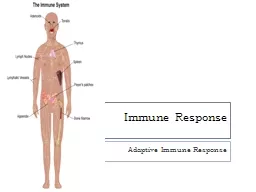

Immune Response Adaptive Immune 2 Adaptive or Acquired Immune Response Protects against infectious agents and abnormal body cells Amplifies the inflammatory response Activates complement 3 ID: 918519
Download Presentation The PPT/PDF document "Immune Response Adaptive" is the property of its rightful owner. Permission is granted to download and print the materials on this web site for personal, non-commercial use only, and to display it on your personal computer provided you do not modify the materials and that you retain all copyright notices contained in the materials. By downloading content from our website, you accept the terms of this agreement.
Slide1
Immune Response
Adaptive Immune Response
Slide2Adaptive Immune
2
Slide3Adaptive or Acquired Immune Response
Protects against infectious agents and abnormal body cells
Amplifies the inflammatory
response
Activates complement
3
Slide4Adaptive Defenses
4
Adaptive immune response
Is systemic
Is
specific
Has
memory
Two separate overlapping arms
Humoral
(antibody-mediated) immunity
Cellular (cell-mediated) immunity
Slide5Acquired or Adaptive Immune Response
There are two major branches of the adaptive immune response
Humoral
Antibody- mediated immune response
Mediated by B-lymphocytes
Cellular
Cell-mediated immune response
Involves the production of cytotoxic T- lymphocytes, activated macrophages, activated NK cells, and cytokines in response to an antigen
Mediated by T-lymphocytes
5
Slide6Antigens
Substances that can mobilize the adaptive defenses and provoke an immune response
Most are large, complex molecules not normally found in the body (nonself)
Slide7Acquired or Adaptive Immune Response
During adaptive immunity:Bone marrow & thymus (primary lymphoid tissues) produce B cells and T cells, respectively
Immature T cells migrate to thymus and become competent T cells
B cells and T cells recirculate through spleen and lymph nodes (secondary lymphoid tissues)
Antigen (Ag) presenting cells (APC) pick up antigen and migrate to secondary lymphoid tissues & interact with T cells and B cells
7
Slide8Antigenic Determinants
Certain parts of an entire antigen that are immunogenic
Antibodies and lymphocyte receptors bind to them
Slide9Antigenic Determinants
Most naturally occurring antigens have numerous antigenic determinants that
Mobilize several different lymphocyte populations
Form different kinds of antibodies against it
Large, chemically simple molecules (e.g., plastics) have little or no immunogenicity
Slide10Examples
“Simple” molecules
Stainless steel
plastics
Slide11Examples
11
Slide12Cells of the Adaptive Immune System
Two types of
lymphocytes
B lymphocytes (B cells)—
humoral
immunity
T lymphocytes (T cells)—cell-mediated
immunity
Antigen-presenting cells (APCs
)
Do not respond to specific antigens
Play essential auxiliary roles in immunity
Slide13Antigen Processing and Presentation
In order to generate adaptive immunity, as well as long lasting memory, Ag should be recognized by T and B
cells
Lymphocytes make up to a billion different types of antigen receptors
Memory
usually improves upon
repeated
exposure to a given infection
13
Slide14Antigen-Presenting Cells (
APCs)
Engulf antigens
Present fragments of antigens to be recognized by T cells
Major types
Dendritic cells in connective tissues and epidermis
Macrophages in connective tissues and lymphoid organs
B cells
Slide15Differences in Innate and Adaptive Immunity
The innate and adaptive immune responses both function to protect against invading organisms, but they differ in a number of
ways
(
1)
The innate immune system is constitutively present and reacts immediately to infection. The adaptive immune response to an invading organism takes some time to
develop
(
2) The innate immune system is not specific in its response and reacts equally well to a variety of organisms, whereas the adaptive immune system is antigen-specific and reacts only with the organism that induced the response
(3
) The adaptive immune system exhibits immunological memory. It "remembers" that it has encountered an invading organism (antigen) and reacts more rapidly on subsequent exposure to the same organism. The innate immune system does not possess a memory.
15
Slide16Acquired Immunity
Type
of Immunity
How acquired by Host
Examples
Active Immunity
Occurs when an individual is exposed to an infectious agent or one of its products (antigens)
Active
Natural Immunity:
Antibodies are produced by the host in response to the infectious agent itself (e.g. Recovery from disease)
Active Artificial Immunity:
Occurs through vaccination with a form of the disease microorganism. It may be dead, attenuated (weakened), or altered so that it will not produce the disease but will cause the body to produce antibodies.
Passive Immunity
As a result of acquisition of antibodies which have been produced
by another animal (by active means) or derived from cells grown in tissue culture
Passive Natural Immunity:
Transfer of antibodies from a mother to her baby through the placenta;
Transfer of antibodies from mother to infant in milk if nursing.
Passive Artificial Immunity:
Acquired through inoculation with antibodies. Injection of immune serum from an individual previously immunized or recovered from disease
16